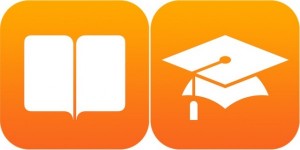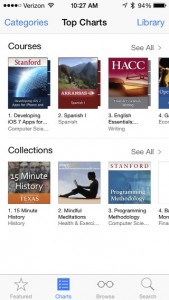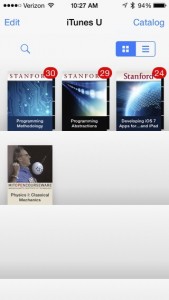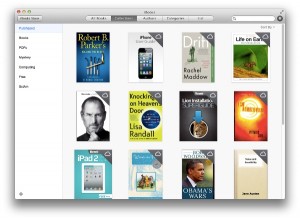 In today’s world, it seems that we have an application for everything. We have apps for managing our schedule, listening to music, and creating and editing video. We have apps for helping us watch what we eat and making sure we get enough exercise. We have apps for entertainment and we have apps for productivity. Within an application market filled to the brim with apps to make our lives easier and more enjoyable, it would just make sense to have an application dedicated to education. As of right now, this market resides as a largely untapped resource. Many of our readers have probably owned an iPhone at one point, and many of these owners have probably noticed an application called “iTunes U”, which they have probably ignored, myself included. iTunes U is Apple’s attempt at an app dedicated to education – populated with courses and integrated with iBooks and the cloud, iTunes U is a work in progress that has the potential to kick start the digital education market, and help revolutionize how we learn in this day and age.
In today’s world, it seems that we have an application for everything. We have apps for managing our schedule, listening to music, and creating and editing video. We have apps for helping us watch what we eat and making sure we get enough exercise. We have apps for entertainment and we have apps for productivity. Within an application market filled to the brim with apps to make our lives easier and more enjoyable, it would just make sense to have an application dedicated to education. As of right now, this market resides as a largely untapped resource. Many of our readers have probably owned an iPhone at one point, and many of these owners have probably noticed an application called “iTunes U”, which they have probably ignored, myself included. iTunes U is Apple’s attempt at an app dedicated to education – populated with courses and integrated with iBooks and the cloud, iTunes U is a work in progress that has the potential to kick start the digital education market, and help revolutionize how we learn in this day and age.
If you’ve been to college in the last 10 years (or been in college for the last 10 years), you’re probably familiar with a learning management system – here at UMass, we have OWL, Moodle, and BlackBoard – to name a few. As of late, these tools have become indispensable in an instructor’s repertoire as they allow the instructors to post all of their educational media online for all of their students to access, as well as generate feedback from the students in the form of online assignments, student message boards, and online tests and quizzes. Theoretically, being able to use such a system should make the entire learning process better for both students and teachers, by helping them stay organized and reducing the load on the teacher (as most online homework can be graded automatically). The problem with the current system is that all of these different features require the students to go back and forth between different sites, making the process more complicated than it needs to be. The goal of iTunes U is to put all of this information in one place, making it even easier for students to get to what they need, using the convenience of the cloud and the accessibility of the App Store.

Currently, iTunes U contains hundreds of courses from schools such as Harvard, MIT, Duke, Yale, Cambridge, Oxford, and UMass, most of which are free for anyone to download. There are two categories of Classes available: Selections, which are a collection of audio and video pertaining to a subject; and Courses, in which the concept that iTunes U wishes to push forward really shines. These courses include all of the parts that make up a traditional learning environment, and begin to reveal that the idea of entirely app based learning isn’t so far-fetched as it may originally seem.
If you’ve ever taken an online class at a university, you’ll find the layout of an iTunes U course very similar. To start things off, you can search for courses within the iTunes U app just like you’d search for other applications within the App Store. Once you’ve decided, you can then subscribe to the course. Since many of the courses offered within iTunes U contain video files (which are traditionally quite large in size), subscribing to a course allows you to have all of the information associated with the course on your personal device without actually having to download all of the information at once. If you’d like to watch a video, and are connected to the internet, iTunes U will stream the video to you, allowing you to watch without having to wait for a download, and without you having to use up storage space on your device. If you’re traveling, or you don’t have an internet connection at home, iTunes U allows you to download the videos straight to your device and store them locally, so you can access them whenever you’d like, regardless of your connection status. This cloud based learning system is definitely ahead of its time, and it won’t be long before this sort of thing is the standard by which other courses measure up.

Alongside the videos, iTunes U courses offer up material to use in conjunction with the video lectures to further enrich your learning experience. This includes (but isn’t limited to) lecture slides, handouts, worksheets, assignments, web links, and readings. The inclusion of this auxiliary material makes the course feel more like an actual college class, and less like a free online lecture.
Perhaps the main significance of the iTunes U program is its focus on the mobile environment. You don’t need a computer to access the class – only your mobile device (whether that be your iPhone or iPad, as iTunes U is currently restricted to Apple devices). If a college were to offer some of their classes on iTunes U, this could be the first step in revolutionizing how our education system works. Currently, it’s almost a requirement for a student to have a laptop to access the various learning management systems across campus. Refocusing these into the more mobile-based environment of iTunes U could allow students to instead use a tablet – which, with the ability to write and touch directly on the screen, could provide a more immersive environment for learning. Imagine if you could access your notes, textbook, homework and lectures, all in one easy to carry place. Sounds nice, right?
iTunes U currently ties into the built in reading application, iBooks, but this tie-in is limited to simply launching the application. Further integration of the two could offer teachers the opportunity to distribute their text through the internet to students enrolled in their class, and not worry about the text leaking out into the public domain. Once textbooks have gone fully digital, it leaves open the opportunity to embed within the text things that couldn’t be done on a paper medium – such as videos, embedded problems, interactive tables, and so on.

Only time will tell if iTunes U, and other digital learning systems, are the future of education. The concept is strong, but underutilized, and the full potential of such a system has yet to be tapped. Keep your eye on digital education – you may just find yourself looking at the future.